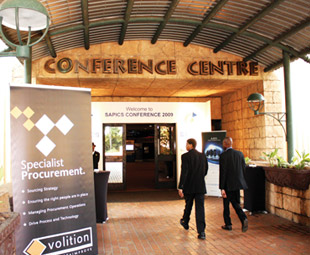Agility for the future

If there is any upside to an economic downturn, it’s that it forces companies to do things more efficiently. And, as delegates to this year’s SAPICS Conference discovered, many supply chain operations are in desperate need of streamlining.
The Association for Operation’s Management of Southern Africa (SAPICS) hosts an annual conference and exhibition at Sun City that has become one of the most anticipated – and well-attended – supply chain and logistics events on the calendar.
Expectations for this year’s conference in terms of attendance, however, were not exceptionally high. According to organisers, it was anticipated that delegate numbers could fall by as much as 40% compared to last year, due to the current economic situation.
Interestingly, though, this was not the case. The 2009 SAPICS Conference and Exhibition turned out to be the second biggest in the event’s 31-year history. A total of 930 delegates and 58 exhibitors descended on Sun City between 12 and 15 July.
And this near record attendance raises an interesting question: why, despite the current need to cut costs, did so many organisations opt to send employees to this conference at great expense? In other words, why did so many companies deem this event too important to miss? To answer this question, one need perhaps only look at the theme of this year’s event.
BRAVE NEW WORLD
 The global economic crisis might not have affected delegate numbers, but that doesn’t mean that it didn’t have a profound influence on this year’s SAPICS conference. Titled “Agility for the future”, the 2009 conference focused primarily on strategies that allow companies to streamline operations during these tough economic times.
The global economic crisis might not have affected delegate numbers, but that doesn’t mean that it didn’t have a profound influence on this year’s SAPICS conference. Titled “Agility for the future”, the 2009 conference focused primarily on strategies that allow companies to streamline operations during these tough economic times.
In addition to presentations dealing with the global economic crisis explicitly, many speakers discussed the various ways in which organisations can cut costs, reduce waste and improve efficiency.
Of course, these issues are always relevant and important, but the global recession has given them a significance that they probably did not have a year or two ago. The fact of the matter is, while things are going well, companies tend to be far more tolerant of inefficiency than they are during difficult times. If profit margins are high, management is more inclined to turn a blind eye to wasteful practices. Once a company comes under financial stress, however, efficiency suddenly becomes important. And an efficient operation often depends on a well-organised and carefully managed supply chain.
STREAMLINING THE SUPPLY CHAIN
If companies want to survive, they need to change the way they think about supply chain management: that was the overall message during the SAPICS 2009 conference. And this doesn’t just apply to the current economic situation. The recession might have highlighted these issues and hastened the implementation of new strategies, but the supply chain environment has changed forever, and companies need to embrace this change.
“A new customer is emerging,” stated Alan Waller, a Supply-Chain Council European leadership team member and a keynote speaker at the conference. “Customers want buying to be easier, faster and cheaper. And this trend doesn’t end with the customer; it is forced up through the value chain.”
According to Waller, this forces suppliers to seek out solution-based offers that they can present to their clients. “In the future, suppliers will increasingly focus on providing customers with solutions, shifting from commodity products to differentiated solutions and reaching out to understand their customers’ customers’ needs. These suppliers will, in turn, expect their suppliers to react in the same way.”
In short, customers are spoilt for choice, and because of this they are becoming increasingly demanding. After all, if one company can’t provide them with what they want, there are hundreds of others waiting in line to offer them the same product or service. And because of this, they are expecting better products and services at lower prices and in less time.
WORKING TOGETHER
In order to live up to the expectations of this new breed of customer, companies have to make drastic changes. New strategies have to be employed in order to make the supply chain process more efficient.
One example is collaboration. “How can businesses ensure the success of their supply chains when they only form a part of it?” asked Waller. “They must work in real partnership with the other businesses that are key to this success.”
Supply chain processes must be integrated and synchronised across organisations in order to reduce waste and improve performance. An excellent example of how collaboration can benefit supply chain management is the collaborative efforts of Kimberly-Clark and Level Faberge. Despite being direct competitors, these two manufacturers have consolidated substantial portions of their distribution operations, which has resulted in improved delivery frequency, fewer out-of-stock situations and improved on-time performance.
The biggest advantage of collaboration is that it reduces waste. By working together, companies are able to create lean supply chains that are far less wasteful and far more efficient.
“Logistics service providers, suppliers and customers have to work together to create more economical transportation processes by eliminating waste in the supply chain. Transportation planning must be centralised across companies and transportation networks must be reconfigured to optimise total delivered cost,” stated Terrence Brown, a supply chain executive for Imperial Logistics, during a presentation.
Brown argued that lean suppliers are far more effective than their more wasteful counterparts. “Lean suppliers are able to respond quickly to changes; they are agile. Their prices are generally lower owing to the efficiencies of lean processes, and their quality has improved to the point that incoming inspection at the next link is no longer required.”
MAKING TECHNOLOGY WORK
Going hand in hand with collaboration and the implementation of lean practices, is making effective use of technology – another key issue that was raised at this year’s conference.
“Surveys done in Europe prior to the year 2000 indicated that technology was the major barrier within the logistics and supply chain arena. Surveys done after 2000 showed that the skill level of employees had become the new major barrier,” stated Waller. “We have all of the technology that we want and need for today’s – and tomorrow’s – supply chain. The real question is: Do we have the people we need to manage this technology?”
According to Waller, companies – and industry as a whole – have to increase the competency levels of those working in the supply chain field and equip them to use technology effectively.
“Industry and academia have an obligation to fund and promote the training programmes required to furnish the next generation of supply chain professionals with the necessary skills,” asserted Waller.
PREPARING FOR THE FUTURE
Overall, SAPICS 2009 provided valuable insight into the future of the logistics and supply chain sector. Strategies such as collaboration, integration, synchronisation and lean manufacturing are not only important during tough economic times; they are the indispensible business practices of the future. A new approach to supply chain management is emerging, and those that don’t adapt will be left behind.
Published by
Focus on Transport
focusmagsa




